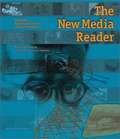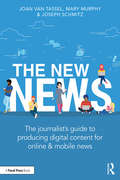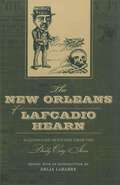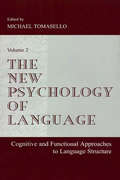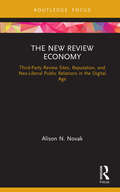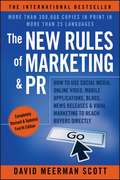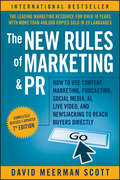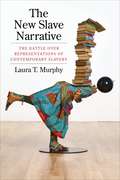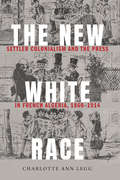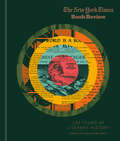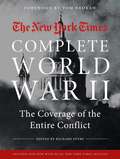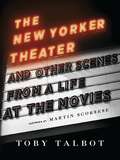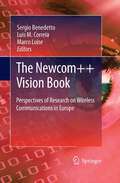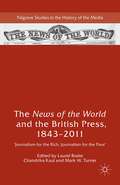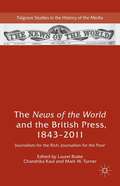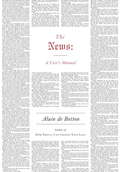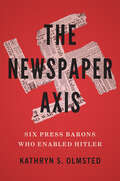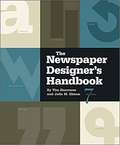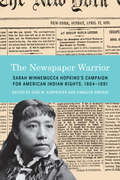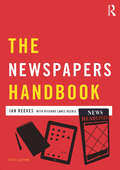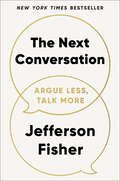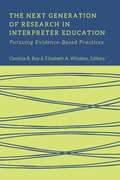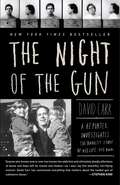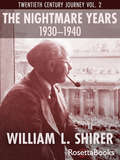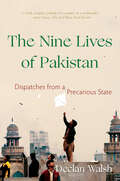- Table View
- List View
The New Media Reader
by Nick Montfort Noah Wardrip-FruinThis reader collects the texts, videos, and computer programs--many of them now almost impossible to find--that chronicle the history and form the foundation of the still-emerging field of new media. General introductions by Janet Murray and Lev Manovich, along with short introductions to each of the texts, place the works in their historical context and explain their significance. The texts were originally published between World War II--when digital computing, cybernetic feedback, and early notions of hypertext and the Internet first appeared--and the emergence of the World Wide Web--when they entered the mainstream of public life. The texts are by computer scientists, artists, architects, literary writers, interface designers, cultural critics, and individuals working across disciplines. The contributors include (chronologically) Jorge Luis Borges, Vannevar Bush, Alan Turing, Ivan Sutherland, William S. Burroughs, Ted Nelson, Italo Calvino, Marshall McLuhan, Billy Kl?Jean Baudrillard, Nicholas Negroponte, Alan Kay, Bill Viola, Sherry Turkle, Richard Stallman, Brenda Laurel, Langdon Winner, Robert Coover, and Tim Berners-Lee. The CD accompanying the book contains examples of early games, digital art, independent literary efforts, software created at universities, and home-computer commercial software. Also on the CD is digitized video, documenting new media programs and artwork for which no operational version exists. One example is a video record of Douglas Engelbart's first presentation of the mouse, word processor, hyperlink, computer-supported cooperative work, video conferencing, and the dividing up of the screen we now call non-overlapping windows; another is documentation of Lynn Hershman's Lorna, the first interactive video art installation.
The New News: The Journalist’s Guide to Producing Digital Content for Online & Mobile News
by Joan Van Tassel Murphy Mary Joseph SchmitzThe New News offers an approachable, practical guide to the 21st-century newsroom, equipping journalists with the skills needed to work expertly, accurately, and efficiently across multiple media platforms. Emphasizing the importance of verification and authentication, the book shows how journalists adapt traditional practices of information-gathering, observation, interviewing, and newswriting for online publications. The text includes comprehensive coverage of key digital and multimedia competencies – capturing multimedia content, "doing" data journalism, mobile reporting, working in teams, participating with global audiences, and building a personal brand. Features developed exclusively for this book include innovative visuals showing the multimedia news structures and workflows used in modern newsrooms; interviews with prominent journalists about their experiences in contemporary journalism; a glossary of up-to-date terms relevant to online journalism; and practical exercises and activities for classroom use, as well as additional downloadable online instructor materials. The New News provides excellent resources to help journalism students and early-career professionals succeed in today’s digital networked news industry. The authors are donating all royalties to nonprofit LION's programs to support local online news publications.
The New Orleans of Lafcadio Hearn: Illustrated Sketches from the Daily City Item (Library of Southern Civilization)
by Delia LaBarreLafcadio Hearn (1850--1904) was a master satirist who displayed a fiery wit both as a writer and as an artist. For seven months in 1880, he surprised and amused the readers of New Orleans with his wood-block "cartoons" and accompanying articles, which were variously funny, scathing, surreal, political, whimsical, and moral. This delightful book collects in their entirety, for the first time, all of the extant satirical columns and woodcut illustrations published in the Daily City Item -- 181 columns in all. Hearn displays immense range, illuminating in words and prints the unique culture of New Orleans, including its Creole history, debauched underworld, corrupt politicians, and voudou practitioners. The columns are expertly annotated by Delia LaBarre, who places them in their unique Crescent City context.With virtually no training in art of any kind, Hearn began creating his illustrations partly to boost the circulation of a small daily newspaper in a competitive market. He believed in the power of satirical cartoons to communicate big ideas in small spaces -- in particular, to reveal the habits, prejudices, and delusions of the current generation. Blind in his left eye (since a boyhood accident) and severely myopic in his right, Hearn nonetheless painstakingly carved out drawings on wood blocks with a penknife to be printed alongside his articles on the newspaper's letterpress. Hearn developed, from the first of these woodcuts to the last, a unique style that expressed the full range of his wit, from razor-sharp condemnation to tender affection.Hearn had a keen eye for the absurd, along with an extraordinary ability to modulate his criticism and praise in a continuum from cauterizing vitriol to palliative balm, from the heaviest sarcasm to the lightest wit. In the pieces collected here, there can be found a unifying thread: Hearn's love/hate relationship with the virtues and vices of New Orleans, a city that continually amused and amazed him.Born in Greece and raised in Ireland, Lafcadio Hearn immigrated to the United States as a teenager and became a newspaper reporter in Cincinnati, Ohio. When he married a black woman, an act that was illegal at the time, the newspaper fired him and Hearn relocated to New Orleans. In the early 1880s his contributions to national publications (like Harper's Weekly and Scribners Magazine) helped mold the popular image of New Orleans as a colorful place of decadence and hedonism. In 1888, Hearn left New Orleans for Japan, where he took the name Koizumi Yakumo and worked as a teacher, journalist, and writer. "And it may come to pass that I shall have stranger things to tell you; for this is a land of magical moons and of witches and of warlocks; and were I to tell you all that I have seen and heard in these years in this enchanted City of Dreams you would verily deem me mad rather than morbid." -- Lafcadio Hearn, 1880, describing New Orleans in a letter to a friend
The New Psychology of Language: Cognitive and Functional Approaches To Language Structure, Volume II (Psychology Press And Routledge Classic Editions Ser.)
by Tomasello MichaelFrom the point of view of psychology and cognitive science, much of modern linguistics is too formal and mathematical to be of much use. The newly emerging approaches to language termed, "Functional and Cognitive Linguistics," however, are much less formally oriented. Instead, functional and cognitive approaches to language structure are typically couched in terms already familiar to cognitive scientists: perception, attention, conceptualization, meaning, symbols, categories, schemas, perspectives, discourse context, social interaction, and communicative goals. The account of human linguistic competence emerging from this new paradigm should be extremely useful to scientists studying how human beings (not formal devices) comprehend, produce, and acquire natural languages. The current volume brings together 10 of the most important linguists in cognitive and functional linguistics whose work is often not easily available to those outside the field. In original contributions, each of these scholars focuses on an important aspect of human linguistic competence, with a special eye to readers who are not professional linguists. Of special importance to all of the contributions are the cognitive and social interactional processes that constitute human linguistic communication. The book is of special interest to psychologists, cognitive scientists, psycholinguists, and developmental psycholinguists, in addition to linguists taking a more psychological approach to language.
The New Review Economy: Third-Party Review Sites, Reputation, and Neo-Liberal Public Relations in the Digital Age (Routledge Focus on Public Relations)
by Alison N. NovakThis book examines third-party review sites (TPRS) and the intersection of the review economy and neoliberal public relations, in order to understand how users and organizations engage the 21st century global review economy. The author applies communication and digital media theories to evaluate contemporary case studies that challenge TPRS and control over digital reputation. Chapters analyze famous cases such as the Texas photographer who sued her clients for negative reviews and activists using Yelp to protest the hunt of "Cecil the Lion," to illustrate the complicated yet important role of TPRS in the review economy. Theories such as neoliberal public relations, digital dialogic communication and cultural intermediaries help explain the impact of reviews and how to apply lessons learned from infamous cases. This nuanced and up to date exploration of the contemporary review economy will offer insights and best practice for academic researchers and upper-level undergraduate students in public relations, digital media, or strategic communication programs.
The New Rules of Marketing & PR: How to Use Social Media, Online Video, Mobile Applications, Blogs, News Releases, and Viral Marketing to Reach Buyers Directly
by David Meerman ScottThe benchmark guide to marketing and PR, updated with the latest social media and marketing trends, tools, and real-world examples of success The New Rules of Marketing & PR, 4th Edition is the pioneering guide to the future of marketing, an international bestseller with more than 300,000 copies sold in over 25 languages.<P><P> It offers a step-by-step action plan for harnessing the power of modern marketing and PR to communicate with buyers directly, raise visibility, and increase sales. It shows how large and small companies, nonprofits, and other organizations can leverage Web-based content to get the right information to the right people at the right time for a fraction of the cost of big-budget campaigns. Including a wealth of compelling case studies and real-world examples of content marketing and inbound marketing success, this is a practical guide to the new reality of reaching buyers when they're eager to hear from you. Includes updated information, examples, and case studies plus an examination of newly popular tools such as Infographics, photo-sharing using Pinterest and Instagram, as well as expanded information on social media such as YouTube, Twitter, Facebook, and LinkedIn David Meerman Scott is a marketing strategist, bestselling author of eight books including three international bestsellers, advisor to emerging companies including HubSpot, and a professional speaker on topics including marketing, leadership, and social media. Prior to starting his own business, he was marketing VP for two U.S. publicly traded companies and was Asia marketing director for Knight-Ridder, at the time one of the world's largest information companies. The New Rules of Marketing & PR offers the single resource for entrepreneurs, business owners, nonprofit managers as well as those working in marketing or publicity departments to build a marketing and PR strategy to grow any business.
The New Rules of Marketing and PR: How to Use Content Marketing, Podcasting, Social Media, AI, Live Video, and Newsjacking to Reach Buyers Directly
by David Meerman ScottThe seventh edition of the pioneering guide to generating attention for your idea or business, packed with new and updated information In the Digital Age, marketing tactics seem to change on a day-to-day basis. As the ways we communicate continue to evolve, keeping pace with the latest trends in social media, the newest online videos, the latest mobile apps, and all the other high-tech influences can seem an almost impossible task. How can you keep your product or service from getting lost in the digital clutter? The seventh edition of The New Rules of Marketing and PR provides everything you need to speak directly to your audience, make a strong personal connection, and generate the best kind of attention for your business. An international bestseller with more than 400,000 copies sold in twenty-nine languages, this revolutionary guide gives you a proven, step-by-step plan for leveraging the power of technology to get your message seen and heard by the right people at the right time. You will learn the latest approaches for highly effective public relations, marketing, and customer communications—all at a fraction of the cost of traditional advertising! The latest edition of The New Rules of Marketing & PR has been completely revised and updated to present more innovative methods and cutting-edge strategies than ever. The new content shows you how to harness AI and machine learning to automate routine tasks so you can focus on marketing and PR strategy. Your life is already AI-assisted. Your marketing should be too! Still the definitive guide on the future of marketing, this must-have resource will help you: Incorporate the new rules that will keep you ahead of the digital marketing curve Make your marketing and public relations real-time by incorporating techniques like newsjacking to generate instant attention when your audience is eager to hear from you Use web-based communication technologies to their fullest potential Gain valuable insights through compelling case studies and real-world examples Take advantage of marketing opportunities on platforms like Facebook Live and Snapchat The seventh edition of The New Rules of Marketing and PR: How to Use Content Marketing, Podcasting, Social Media, AI, Live Video, and Newsjacking to Reach Buyers Directly is the ideal resource for entrepreneurs, business owners, marketers, PR professionals, and managers in organizations of all types and sizes.
The New Slave Narrative: The Battle Over Representations of Contemporary Slavery
by Laura MurphyA century and a half after the abolition of slavery in the United States, survivors of contemporary forms of enslavement from around the world have revived a powerful tool of the abolitionist movement: first-person narratives of slavery and freedom. Just as Frederick Douglass, Harriet Jacobs, and others used autobiographical testimonies in the fight to eradicate slavery, today’s new slave narrators play a crucial role in shaping an antislavery agenda. Their writings unveil the systemic underpinnings of global slavery while critiquing the precarity of their hard-fought freedom. At the same time, the demands of antislavery organizations, religious groups, and book publishers circumscribe the voices of the enslaved, coopting their narratives in support of alternative agendas.In this pathbreaking interdisciplinary study, Laura T. Murphy argues that the slave narrative has reemerged as a twenty-first-century genre that has gained new currency in the context of the memoir boom, post-9/11 anti-Islamic sentiment, and conservative family-values politics. She analyzes a diverse range of dozens of book-length accounts of modern slavery from Africa, Asia, the United States, the United Kingdom, and Europe, examining the narrative strategies that survivors of slavery employ to make their experiences legible and to promote a reinvigorated antislavery agenda. By putting these stories into conversation with one another, The New Slave Narrative reveals an emergent survivor-centered counterdiscourse of collaboration and systemic change that offers an urgent critique of the systems that maintain contemporary slavery, as well as of the human rights industry and the antislavery movement.
The New White Race: Settler Colonialism and the Press in French Algeria, 1860-1914 (France Overseas: Studies in Empire and Decolonization)
by Charlotte Ann LeggThe New White Race traces the development of the press in Algeria between 1860 and 1914, examining the particular role of journalists in shaping the power dynamics of settler colonialism. Constrained in different ways by the limitations imposed on free expression in a colonial context, diverse groups of European settlers, Algerian Muslims, and Algerian Jews nevertheless turned to the press to articulate their hopes and fears for the future of the land they inhabited and to imagine forms of community which would continue to influence political debates until the Algerian War. The frontiers of these imagined communities did not necessarily correlate with those of the nation—either French or Algerian—but framed processes of identification that were at once local, national, and transnational.The New White Race explores these processes of cultural and political identification, highlighting the production practices, professional networks, and strategic-linguistic choices mobilized by journalists as they sought to influence the sentiments of their readers and the decisions of the French state. Announcing the creation of a &“new white race&” among the mixed European population of Algeria, settler journalists hoped to increase the autonomy of the settler colony without forgoing the protections afforded by their French rulers. Their ambivalent expressions of &“French&” belonging, however, reflected tensions among the colonizers; these tensions were ably exploited by those who sought to transform or contest French imperial rule.
The New York Times Book Review: 125 Years of Literary History
by The New York TimesFrom the longest-running, most influential book review in America, here is its best, funniest, strangest, and most memorable coverage over the past 125 years.Since its first issue on October 10, 1896, The New York Times Book Review has brought the world of ideas to the reading public. It is the publication where authors have been made, and where readers first encountered the classics that have enriched their lives. Now the editors have curated the Book Review&’s dynamic 125-year history, which is essentially the story of modern American letters. Brimming with remarkable reportage and photography, this beautiful book collects interesting reviews, never-before-heard anecdotes about famous writers, and spicy letter exchanges. Here are the first takes on novels we now consider masterpieces, including a long-forgotten pan of Anne of Green Gables and a rave of Mrs. Dalloway, along with reviews and essays by Langston Hughes, Eudora Welty, James Baldwin, Nora Ephron, and more. With scores of stunning vintage photographs, many of them sourced from the Times&’s own archive, readers will discover how literary tastes have shifted through the years—and how the Book Review&’s coverage has shaped so much of what we read today.
The New York Times Complete World War II: The Coverage of the Entire Conflict
by Tom Brokaw Richard Overy The New York TimesExperience the history, politics, and tragedy of World War II through the original, often firsthand daily reportage of The New York Times, our country's newspaper of record.The Times' complete coverage of World War II is now available in a paperback edition of this unique book. Hundreds of the most riveting articles from the archives of the Times including firsthand accounts of major events and little-known anecdotes have been selected for inclusion in The New York Times: World War II. The book covers the biggest battles of the war, from the Battle of the Bulge to the Battle of Iwo Jima, as well as moving stories from the home front and profiles of noted leaders and heroes such as Winston Churchill and George Patton.A respected World War II historian and writer, editor Richard Overy guides readers through the articles, putting the events into historical context. Beautifully designed and illustrated with hundreds of maps and historical photographs, it's the perfect gift for any war, politics, or history buff.
The New Yorker Theater and Other Scenes from a Life at the Movies
by Toby TalbotThe nation didn't know it, but 1960 would change American film forever, and the revolution would occur nowhere near a Hollywood set. With the opening of the New Yorker Theater, a cinema located at the heart of Manhattan's Upper West Side, cutting-edge films from around the world were screened for an eager audience, including the city's most influential producers, directors, critics, and writers. Woody Allen, Martin Scorsese, Susan Sontag, Andrew Sarris, and Pauline Kael, among many others, would make the New Yorker their home, trusting in the owners' impeccable taste and incorporating much of what they viewed into their work. In this irresistible memoir, Toby Talbot, co-owner and proud "matron" of the New Yorker Theater, reveals the story behind Manhattan's wild and wonderful affair with art-house film. With her husband Dan, Talbot showcased a range of eclectic films, introducing French New Wave and New German cinema, along with other groundbreaking genres and styles. As Vietnam protests and the struggle for civil rights raged outside, the Talbots also took the lead in distributing political films, such as Bernard Bertolucci's Before the Revolution, and documentaries, such as Shoah and Point of Order.Talbot enhances her stories with selections from the New Yorker's essential archives, including program notes by Jack Kerouac, Jules Feiffer, Peter Bogdanovich, Jonas Mekas, Jack Gelber, and Harold Humes. These artifacts testify to the deeply engaged and collaborative spirit behind each showing, and they illuminate the myriad-and often entertaining-aspects of theater operation. All in all, Talbot's tales capture the highs and lows of a thrilling era in filmmaking.
The Newcom++ Vision Book
by Marco Luise Luis M. Correia Sergio BenedettoThe Book contains the Vision of the researchers of the European Network of Excellence NEWCOM++ (Network of Excellence on Wireless COMmunication) on the present and future status of Wireless Communication Networks. In its content, the community of NEWCOM++ researchers, shaped under the common ground of a mainly academic network of excellence, have distilled their scientific wisdom in a number of areas characterized by the common denominator of wireless communications, by identifying the medium-long term research tendencies/problems, describing the tools to face them and providing a relatively large number of references for the interested reader. The identified areas and the researchers involved in their redaction reflect the intersection of the major topics in wireless communications with those that are deeply investigated in NEWCOM++; they are preceded by an original description of the main trends in user/society needs and the degree of fulfilment that ongoing and future wireless communications standards will more likely help achieving. The appendix of the Book contains a list of "Millenium Problems", seminal problems in the area of wireless communication networks, characterized by being crucial and still unsolved. The problems have been identified by NEWCOM++ researchers and filtered by the editors of the Vision Book.
The News of the World and the British Press, 1843-2011: 'Journalism for the Rich, Journalism for the Poor' (Palgrave Studies in the History of the Media)
by Chandrika Kaul Mark W. Turner Laurel BrakeThis volume is the first scholarly treatment of the News of the World from news-rich broadsheet to sensational tabloid. Contributors uncover new facts and discuss a range of topics including Sunday journalism, gender, crime, empire, political cartoons, the mass market, investigative techniques and the Leveson Inquiry.
The News of the World and the British Press, 1843–2011: 'journalism for the Rich, Journalism for the Poor' (Palgrave Studies in the History of the Media)
by Chandrika Kaul Mark W. Turner Laurel BrakeThe News of the World and the British Press, 1843–2011.
The News: A User's Manual
by Alain De BottonThe news is everywhere. We can't stop constantly checking it on our computer screens, but what is this doing to our minds? We are never really taught how to make sense of the torrent of news we face every day, writes Alain de Botton (author of the best-selling The Architecture of Happiness), but this has a huge impact on our sense of what matters and of how we should lead our lives. In his dazzling new book, de Botton takes twenty-five archetypal news stories--including an airplane crash, a murder, a celebrity interview and a political scandal--and submits them to unusually intense analysis with a view to helping us navigate our news-soaked age. He raises such questions as Why are disaster stories often so uplifting? What makes the love lives of celebrities so interesting? Why do we enjoy watching politicians being brought down? Why are upheavals in far-off lands often so boring? In The News: A User's Manual, de Botton has written the ultimate guide for our frenzied era, certain to bring calm, understanding and a measure of sanity to our daily (perhaps even hourly) interactions with the news machine.(With black-and-white illustrations throughout.)From the Hardcover edition.
The Newspaper Axis: Six Press Barons Who Enabled Hitler
by Kathryn S. OlmstedHow six conservative media moguls hindered America and Britain from entering World War II &“A landmark in the political history of journalism.&”—Michael Kazin, author of What It Took to Win: A History of the Democratic Party As World War II approached, the six most powerful media moguls in America and Britain tried to pressure their countries to ignore the fascist threat. The media empires of Robert McCormick, Joseph and Eleanor Patterson, and William Randolph Hearst spanned the United States, reaching tens of millions of Americans in print and over the airwaves with their isolationist views. Meanwhile in England, Lord Rothermere&’s Daily Mail extolled Hitler&’s leadership and Lord Beaverbrook&’s Daily Express insisted that Britain had no interest in defending Hitler&’s victims on the continent. Kathryn S. Olmsted shows how these media titans worked in concert—including sharing editorial pieces and coordinating their responses to events—to influence public opinion in a right-wing populist direction, how they echoed fascist and anti‑Semitic propaganda, and how they weakened and delayed both Britain&’s and America&’s response to Nazi aggression.
The Newspaper Designer's Handbook
by Tim Harrower Julie ElmanThroughout the seven editions of this book, Harrower has successfully deconstructed the process of laying out newspaper pages. For journalism students and professionals alike, countless designers have used this book to learn how to design and improve their skills as visual communicators. Harrower’s unique voice and quirky sense of humor are still very much alive in the seventh edition.
The Newspaper Warrior: Sarah Winnemucca Hopkins's Campaign for American Indian Rights, 1864-1891
by Cari M. Carpenter Carolyn Sorisio Sarah Winnemucca HopkinsSarah Winnemucca Hopkins (Northern Paiute) has long been recognized as an important nineteenth-century American Indian activist and writer. Yet her acclaimed performances and speaking tours across the United States, along with the copious newspaper articles that grew out of those tours, have been largely ignored and forgotten. The Newspaper Warrior presents new material that enhances public memory as the first volume to collect hundreds of newspaper articles, letters to the editor, advertisements, book reviews, and editorial comments by and about Sarah Winnemucca Hopkins. This anthology gathers together her literary production for newspapers and magazines from her 1864 performances in San Francisco to her untimely death in 1891, focusing on the years 1879 to 1887, when Winnemucca Hopkins gave hundreds of lectures in the eastern and western United States; published her book, Life among the Piutes: Their Wrongs and Claims (1883); and established a bilingual school for Native American children. Editors Cari M. Carpenter and Carolyn Sorisio masterfully assemble these exceptional and long-forgotten articles in a call for a deeper assessment and appreciation of Winnemucca Hopkins’s stature as a Native American author, while also raising important questions about the nature of Native American literature and authorship.
The Newspapers Handbook (Media Practice)
by Richard Keeble Ian ReevesThis new edition of The Newspapers Handbook presents an enlightening examination of an ever-evolving industry, engaging with key contemporary issues, including reporting in the digital age and ethical and legislative issues following the hacking scandal to display a comprehensive anatomy of the modern newsroom. Richard Lance Keeble and Ian Reeves offer readers expert practical advice, drawing on a wide range of examples from print and digital news sources to illustrate best practice and the political, technological and financial realities of newspaper journalism today. Other key areas explored include: the language of news basic reporting the art of interviewing feature writing the role of social media in reporting investigative reporting court reporting reporting on national and local government guidance on training and careers for those entering the industry.
The Next Conversation: Argue Less, Talk More
by Jefferson FisherTHE INSTANT NEW YORK TIMES BESTSELLERFrom communication expert Jefferson Fisher, the definitive book on making your next conversation the one that changes everythingNo matter who you&’re talking to, The Next Conversation gives you immediately actionable strategies and phrases that will forever change how you communicate. Jefferson Fisher, trial lawyer and one of the leading voices on real-world communication, offers a tried-and-true framework that will show you how to transform your life and your relationships by improving your next conversation.Fisher has gained millions of followers through short, simple, practical videos teaching people how to argue less and talk more. Whether it&’s handling a heated conversation, dealing with a difficult personality, or standing your ground with confidence, his down-to-earth teachings have helped countless people navigate life&’s toughest situations. Now for the first time, Fisher has distilled his three-part communication system (Say it with control, Say it with confidence, Say it to connect) that can easily be applied to any situation.You will learn:Why you should never &“win&” an argumentHow to assert yourself and communicate with intentionHow to set boundaries and frame conversationsWhy saying less is often moreHow to overcome conflict with connectionThe Next Conversation will give you practical phrases that will lead to powerful results, from breaking down defensiveness in a hard talk with a family member to finding your own assertive voice at the boardroom conference table. Your every word matters, and by controlling how you communicate every day, you will create waves of positive impact that will resonate throughout your relationships to last a lifetime.Everything you want to say, and how you want to say it, can be found in The Next Conversation.
The Next Generation of Research in Interpreter Education: Pursuing Evidence-Based Practices (The Interpreter Education Series #10)
by Cynthia B. Roy Elizabeth A. WinstonThis collection contributes to an emerging body of research in sign language interpreter education, a field in which research on teaching practices has been rare. The Next Generation of Research in Interpreter Education investigates learning experiences and teaching practices that provide the evidence necessary to inform and advance instructional approaches. The five studies included in this volume examine role-play activities in the classroom, the experiences of Deaf students in interpreting programs, reducing anxiety in the interpreting process, mentoring, and self-assessment. The contributors are a nascent group of educators who represent a growing mastery of contemporary standards in interpreter education. Their chapters share a common theme: the experiences and learning environments of students as they progress toward entry into the interpreting profession.
The Night of the Gun: A reporter investigates the darkest story of his life. His own.
by David CarrFrom David Carr (1956–2015), the “undeniably brilliant and dogged journalist” (Entertainment Weekly) and author of the instant New York Times bestseller that the Chicago Sun-Times called “a compelling tale of drug abuse, despair, and, finally, hope.”Do we remember only the stories we can live with? The ones that make us look good in the rearview mirror? In The Night of the Gun, David Carr redefines memoir with the revelatory story of his years as an addict and chronicles his journey from crack-house regular to regular columnist for The New York Times. Built on sixty videotaped interviews, legal and medical records, and three years of reporting, The Night of the Gun is a ferocious tale that uses the tools of journalism to fact-check the past. Carr’s investigation of his own history reveals that his odyssey through addiction, recovery, cancer, and life as a single parent was far more harrowing—and, in the end, more miraculous—than he allowed himself to remember. Fierce, gritty, and remarkable, The Night of the Gun is “an odyssey you’ll find hard to forget” (People).
The Nightmare Years, 1930–1940 (Twentieth Century Journey #2)
by William L. ShirerThe famous journalist and author of The Rise and Fall of the Third Reich documents his front row seat at the pivotal events leading up to World War II. In the second of a three-volume series, William L. Shirer tells the story of his own eventful life, detailing the most notable moments of his career as a journalist stationed in Germany during the rise of the Third Reich. Shirer was there while Hitler celebrated his new domination of Germany, unleashed the Blitzkrieg on Poland, and began the conflict that would come to be known as World War II. This remarkable account tells the story of an American reporter caught in a maelstrom of war and politics, desperately trying to warn Europe and the United States about the dangers to come. This memoir gives readers a chance to relive one of the most turbulent periods in twentieth century history—painting a stunningly intimate portrait of a dangerous decade. &“Mr. Shirer stirs the ashes of memory in a personal way that results in both a strong view of world events and of the need for outspoken journalism. Had Mr. Shirer been merely a bland &‘objective&’ reporter without passion while covering Hitler&’s Third Reich, this book and his other histories could never have been written.&” —The New York Times
The Nine Lives of Pakistan: Dispatches From A Precarious State
by Declan WalshA New York Times New Book to Watch For (November 2020) The former New York Times Pakistan bureau chief paints an arresting, up-close portrait of a fractured country. Declan Walsh is one of the New York Times’s most distinguished international correspondents. His electrifying portrait of Pakistan over a tumultuous decade captures the sweep of this strange, wondrous, and benighted country through the dramatic lives of nine fascinating individuals. On assignment as the country careened between crises, Walsh traveled from the raucous port of Karachi to the salons of Lahore, and from Baluchistan to the mountains of Waziristan. He met a diverse cast of extraordinary Pakistanis—a chieftain readying for war at his desert fort, a retired spy skulking through the borderlands, and a crusading lawyer risking death for her beliefs, among others. Through these “nine lives” he describes a country on the brink—a place of creeping extremism and political chaos, but also personal bravery and dogged idealism that defy easy stereotypes. Unbeknownst to Walsh, however, an intelligence agent was tracking him. Written in the aftermath of Walsh’s abrupt deportation, The Nine Lives of Pakistan concludes with an astonishing encounter with that agent, and his revelations about Pakistan’s powerful security state. Intimate and complex, attuned to the centrifugal forces of history, identity, and faith, The Nine Lives of Pakistan offers an unflinching account of life in a precarious, vital country.
